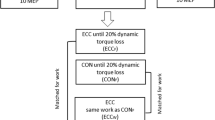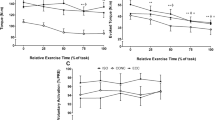Abstract
It has been shown that mean muscle fiber conduction velocity (CV) can be acutely impaired after eccentric exercise. However, it is not known whether this applies to other exercise modes. Therefore, the purpose of this experiment was to compare the effects of eccentric and concentric exercises on CV, and amplitude and frequency content of surface electromyography (sEMG) signals up to 24 h post-exercise. Multichannel sEMG signals were recorded from biceps brachii muscle of the exercised arm during isometric maximal voluntary contraction (MVC) and electrically evoked contractions induced by motor-point stimulation before, immediately after and 2 h after maximal eccentric (ECC group, N = 12) and concentric (CON group, N = 12) elbow flexor exercises. Isometric MVC decreased in CON by 21.7 ± 12.0% (±SD, p < 0.01) and by 30.0 ± 17.7% (p < 0.001) in ECC immediately post-exercise when compared to baseline. At 2 h post-exercise, ECC showed a reduction in isometric MVC by 24.7 ± 13.7% (p < 0.01) when compared to baseline, while no significant reduction (by 8.0 ± 17.0%, ns) was observed in CON. Similarly, reduction in CV was observed only in ECC both during the isometric MVC (from baseline of 4.16 ± 0.3 to 3.43 ± 0.4 m/s, p < 0.001) and the electrically evoked contractions (from baseline of 4.33 ± 0.4 to 3.82 ± 0.3 m/s, p < 0.001). In conclusion, eccentric exercise can induce a greater and more prolonged reduction in muscle force production capability and CV than concentric exercise.






Similar content being viewed by others
References
Armstrong RB (1984) Mechanisms of exercise-induced delayed onset muscular soreness: a brief review. Med Sci Sports Exerc 16:529–538
Babault N, Pousson M, Ballay Y, Van Hoecke J (2001) Activation of human quadriceps femoris during isometric, concentric, and eccentric contractions. J Appl Physiol 91:2628–2634
Belcastro AN, Shewchuk LD, Raj DA (1998) Exercise-induced muscle injury: a calpain hypothesis. Mol Cell Biochem 179:135–145
Bigland B, Lippold OC (1954) The relation between force, velocity and integrated electrical activity in human muscles. J Physiol 123:214–224
Bonde-Petersen F, Knuttgen HG, Henriksson J (1972) Muscle metabolism during exercise with concentric and eccentric contractions. J Appl Physiol 33:792–795
Burton F, Dorstelmann U, Hutter OF (1988) Single-channel activity in sarcolemmal vesicles from human and other mammalian muscles. Muscle Nerve 11:1029–1038
Chen TC (2003) Effects of a second bout of maximal eccentric exercise on muscle damage and electromyographic activity. Eur J Appl Physiol 89:115–121
Clarkson PM, Byrnes WC, McCormick KM, Turcotte LP, White JS (1986) Muscle soreness and serum creatine kinase activity following isometric, eccentric, and concentric exercise. Int J Sports Med 7:152–155
Clarkson PM, Nosaka K, Braun B (1992) Muscle function after exercise-induced muscle damage and rapid adaptation. Med Sci Sports Exerc 24:512–520
Clausen T (1986) Regulation of active Na+–K+ transport in skeletal muscle. Physiol Rev 66:542–580
Corona BT, Balog EM, Doyle JA, Rupp JC, Luke RC, Ingalls CP (2010) Junctophilin damage contributes to early strength deficits and EC coupling failure after eccentric contractions. Am J Physiol Cell Physiol 298:C365–C376
Davies CT, White MJ (1981) Muscle weakness following eccentric work in man. Pflugers Arch 392:168–171
Edwards RH, Hill DK, Jones DA, Merton PA (1977) Fatigue of long duration in human skeletal muscle after exercise. J Physiol 272:769–778
Flucher BE, Daniels MP (1989) Distribution of Na+ channels and ankyrin in neuromuscular junctions is complementary to that of acetylcholine receptors and the 43 kd protein. Neuron 3:163–175
Hodgkin AL, Horowicz P (1959) The influence of potassium and chloride ions on the membrane potential of single muscle fibres. J Physiol 148:127–160
Hortobagyi T, Houmard J, Fraser D, Dudek R, Lambert J, Tracy J (1998) Normal forces and myofibrillar disruption after repeated eccentric exercise. J Appl Physiol 84:492–498
Jones DA, Newham DJ, Round JM, Tolfree SE (1986) Experimental human muscle damage: morphological changes in relation to other indices of damage. J Physiol 375:435–448
Jones DA, Newham DJ, Torgan C (1989) Mechanical influences on long-lasting human muscle fatigue and delayed-onset pain. J Physiol 412:415–427
Juel C (1988) Muscle action potential propagation velocity changes during activity. Muscle Nerve 11:714–719
Katz B (1939) The relation between force and speed in muscular contraction. J Physiol 96:45–64
Komi PV, Linnamo V, Silventoinen P, Sillanpaa M (2000) Force and EMG power spectrum during eccentric and concentric actions. Med Sci Sports Exerc 32:1757–1762
Kroon GW, Naeije M (1991) Recovery of the human biceps electromyogram after heavy eccentric, concentric or isometric exercise. Eur J Appl Physiol Occup Physiol 63:444–448
Lieber RL, Friden J (1988) Selective damage of fast glycolytic muscle fibres with eccentric contraction of the rabbit tibialis anterior. Acta Physiol Scand 133:587–588
Linnamo V, Bottas R, Komi PV (2000) Force and EMG power spectrum during and after eccentric and concentric fatigue. J Electromyogr Kinesiol 10:293–300
Masuda T, Sadoyama T (1986) The propagation of single motor unit action potentials detected by a surface electrode array. Electroencephalogr Clin Neurophysiol 63:590–598
McBride TA, Stockert BW, Gorin FA, Carlsen RC (2000) Stretch-activated ion channels contribute to membrane depolarization after eccentric contractions. J Appl Physiol 88:91–101
McFadden LK, McComas AJ (1996) Late depression of muscle excitability in humans after fatiguing stimulation. J Physiol 496(Pt 3):851–855
McGill KC, Dorfman LJ (1984) High-resolution alignment of sampled waveforms. IEEE Trans Biomed Eng 31:462–468
McNeil PL, Khakee R (1992) Disruptions of muscle fiber plasma membranes. Role in exercise-induced damage. Am J Pathol 140:1097–1109
Merletti R, Knaflitz M, De Luca CJ (1990) Myoelectric manifestations of fatigue in voluntary and electrically elicited contractions. J Appl Physiol 69:1810–1820
Merletti R, Roy SH, Kupa E, Roatta S, Granata A (1999) Modeling of surface myoelectric signals—Part II: model-based signal interpretation. IEEE Trans Biomed Eng 46:821–829
Merton PA (1954) Voluntary strength and fatigue. J Physiol 123:553–564
Michaut A, Pousson M, Babault N, Van Hoecke J (2002) Is eccentric exercise-induced torque decrease contraction type dependent? Med Sci Sports Exerc 34:1003–1008
Morgan DL, Allen DG (1999) Early events in stretch-induced muscle damage. J Appl Physiol 87:2007–2015
Newham DJ, Mills KR, Quigley BM, Edwards RH (1983) Pain and fatigue after concentric and eccentric muscle contractions. Clin Sci (Lond) 64:55–62
Nosaka K, Clarkson PM (1996) Variability in serum creatine kinase response after eccentric exercise of the elbow flexors. Int J Sports Med 17:120–127
Pallotta BS (1985) Calcium-activated potassium channels in rat muscle inactivate from a short-duration open state. J Physiol 363:501–516
Piitulainen H, Komi P, Linnamo V, Avela J (2008) Sarcolemmal excitability as investigated with M-waves after eccentric exercise in humans. J Electromyogr Kinesiol 18:672–681
Piitulainen H, Bottas R, Komi P, Linnamo V, Avela J (2010) Impaired action potential conduction at high force levels after eccentric exercise. J Electromyogr Kinesiol 20:879–887
Ruff RL (1999) Effects of temperature on slow and fast inactivation of rat skeletal muscle Na(+) channels. Am J Physiol 277:C937–C947
Ruff RL, Whittlesey D (1992) Na+ current densities and voltage dependence in human intercostal muscle fibres. J Physiol 458:85–97
Sbriccoli P, Felici F, Rosponi A et al (2001) Exercise induced muscle damage and recovery assessed by means of linear and non-linear sEMG analysis and ultrasonography. J Electromyogr Kinesiol 11:73–83
Sjogaard G (1990) Exercise-induced muscle fatigue: the significance of potassium. Acta Physiol Scand Suppl 593:1–63
Smith IC, Newham DJ (2007) Fatigue and functional performance of human biceps muscle following concentric or eccentric contractions. J Appl Physiol 102:207–213
Stalberg E (1966) Propagation velocity in human muscle fibers in situ. Acta Physiol Scand Suppl 287:1–112
Stauber WT (1989) Eccentric action of muscles: physiology, injury, and adaptation. Exerc Sport Sci Rev 17:157–185
Stauber WT, Clarkson PM, Fritz VK, Evans WJ (1990) Extracellular matrix disruption and pain after eccentric muscle action. J Appl Physiol 69:868–874
Street SF, Ramsey RW (1965) Sarcolemma: transmitter of active tension in frog skeletal muscle. Science 149:1379–1380
Takekura H, Fujinami N, Nishizawa T, Ogasawara H, Kasuga N (2001) Eccentric exercise-induced morphological changes in the membrane systems involved in excitation–contraction coupling in rat skeletal muscle. J Physiol 533:571–583
Vijayan K, Thompson JL, Norenberg KM, Fitts RH, Riley DA (2001) Fiber-type susceptibility to eccentric contraction-induced damage of hindlimb-unloaded rat AL muscles. J Appl Physiol 90:770–776
Warren GL, Ingalls CP, Shah SJ, Armstrong RB (1999) Uncoupling of in vivo torque production from EMG in mouse muscles injured by eccentric contractions. J Physiol 515(Pt 2):609–619
Westing SH, Cresswell AG, Thorstensson A (1991) Muscle activation during maximal voluntary eccentric and concentric knee extension. Eur J Appl Physiol Occup Physiol 62:104–108
Acknowledgments
This work was supported by a grant to Prof. Avela from the Academy of Finland (#123151) and by grants to Prof. Merletti from Compagnia di San Paolo and Fondazione CRT.
Author information
Authors and Affiliations
Corresponding author
Additional information
Communicated by Alain Martin.
Rights and permissions
About this article
Cite this article
Piitulainen, H., Botter, A., Merletti, R. et al. Muscle fiber conduction velocity is more affected after eccentric than concentric exercise. Eur J Appl Physiol 111, 261–273 (2011). https://doi.org/10.1007/s00421-010-1652-y
Accepted:
Published:
Issue Date:
DOI: https://doi.org/10.1007/s00421-010-1652-y




